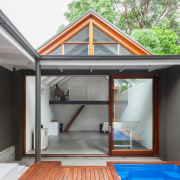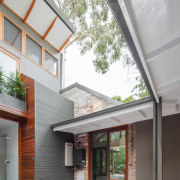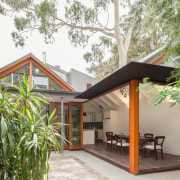Internal landscape
Japanese courtyard-style home
Introducing new structures to a restricted space might seem like enough of a task for an architect. Then there is the need for everything to feel light, spacious and open.
This new home by architect Stephen Rofail involved repurposing a six metre-wide laneway, together with an existing studio, both at the rear boundary of a residential property. In this space the owners wanted a two-bedroom, light-filled residence looking back to the main house, and a new self-contained artist's studio.
"The tricky shape and limited footprint greatly informed the design," Rofail says.
"To create a degree of separation from the main house we pushed the new home to the rear and side boundaries, and provided views to the lush trees in the central rear yard, rather like a Japanese courtyard house."
The Japanese house concept lies behind several other aspects of the design. The linked home and studio form a series of gabled pavilions with steeply raked ceilings and clerestory windows.

"Breaking the new house into pavilions plays down its size and nestles the home into its urban forest landscape," says the architect. "Walls of glass sliding doors mean owners or guests can step from the dining room or living spaces straight into the courtyard setting. When all the doors are drawn back, the interiors and outdoors become one."
Another connection is provided by the exposed beams and rafters in the raked ceiling their branch-like forms echo the trees outside, says Rofail.
Despite the separated roof forms of the house, the interior is open plan. Both the dining room and living room alongside open to the courtyard garden.
The two-storey section of the house, on the rear and side boundaries, accommodates the master suite upstairs and a guest bedroom and bathroom downstairs.
The house is built with an on-ground slab, masonry walls and timber roof framing. The glazed openings to the living and dining area, as well as the artist's studio, are supported by steel portal frames. V-groove lining boards were used for the external cladding of the first floor master suite and all the interior ceiling lining and exterior soffit lining.

Rofail says texture and detail were important to maintain the serene feeling of a forest retreat. Given the natural outlooks, the house is finished in a rich stained cedar and earthy paint colours. An aged oak floor runs right through the home, which is another nod to the setting.
"Part of the brief for the new house was to optimise natural ventilation and this style of architecture allowed us to do that," says Rofail. "As hot air rises, it is released through the open louvres in the upper windows, which in turn draw in cooler air from below. At the same time, the clerestory windows and high eaves allow maximum natural light to penetrate."
Just as the courtyard separates the old house from the new, a central deck and pool provide an internal division between the two-storey private section of the new house and the self-contained artist's studio. Here again, the facades are oriented to face each other. The studio has the same gabled roof form and wall of sliding glass doors as the house, ensuring this working space is also light-filled and airy.
The entry to the secondary yard and studio from the main courtyard is through an old brick wall. This was retained from the original structure Rofail says he was keen to incorporate what he could of the old into the new. To the right of the entry, a protruding wall shows the position of the staircase inside the home. This element is finished in Mini Orb, creating a contrasting feature surface. The sleek corrugated iron facing also echoes the lines of the V-groove panels on the cladding and eaves, as does the timber decking around the pool.
"Despite the rather tight footprint, and urban high-density surroundings, this design achieves a sense of privacy and spaciousness by turning inward, with the public spaces looking to the leafy heart of the property," says Rofail.
Credit list
Architect and interior designer
Kitchen manufacturer
Roofing
Flooring
Fireplace
Cabinetry
Splashback
Mixer
Dishwasher
Builder
Cladding and ceiling lining
Lighting
Pool
Benchtops
Sink
Appliance supplier
Story by: Charles Moxham
Home kitchen bathroom commercial design
Renovation Trends Vol. 30/5
Renovation Trends showcases innovative makeovers – big and small. The book features kitchens, bathrooms, interior makeov...
Read More













